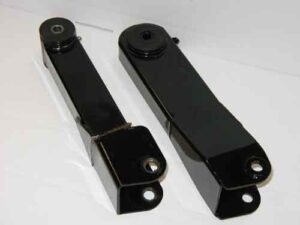GM A-Body FAQ
GM A-Body Technical Page
This page contains technical data specific to the GM A-Body Platforms. Here you will find recommended upgrades to meet specific needs, FAQ’s, and technical videos.
GM A-Body Platform 1964-1972
Common Models:
- Buick Skylark
- Chevrolet Chevelle
- Chevrolet El Camino
- Chevrolet Malibu
- Oldsmobile 442
- Oldsmobile Cutlas
- Pontiac Lemans
- Pontiac GTO
- Pontiac Tempast
Choose a FAQ Category:
Q) Why should I choose Hotchkis Sport Suspension Tubular A-Arms vs the Competition?
Answer: All Hotchkis Tubular A-Arms are manufacturerd in the USA using the latest CAD manufacturing processes. Through a combination of inovative, value adding features, Hotchkis gives you the highest quality A-Arms on the market. Check out the key design features below.
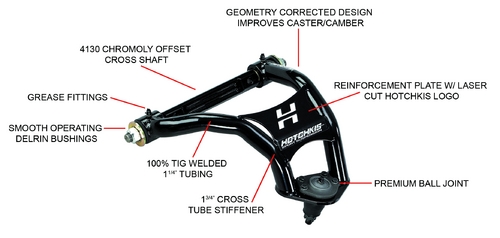
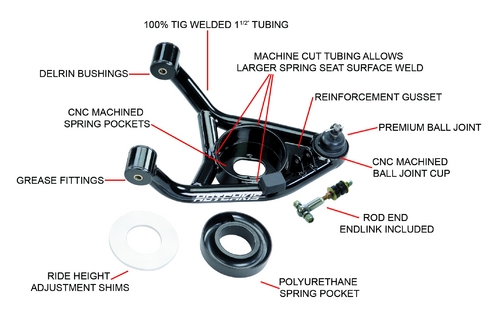
Q) What are the advantages from running the Hotchkis upper a-ams vs. stock a-arms on my 1964-1972 A-body?
Answer: The answer to this question varies depending on the arm chosen, so we will break it up by item number and intended use.
Stock or Dropped Spindles
#1102 This Hotchkis Sport Suspension Tubular Upper A-Arm is designed for vehicles using stock sprindles, or any form of stock replacement drop spindle. The Geometry corrected design improves caster and camber curves, improving handling and stability.
Increased caster will improve high speed stability and cause the vehicle to track straighter.
Improved camber curve will keep more of the tire in contact with the road under hard cornering.
Features:It features smooth operating Delrin® bushings, 4130 chromoly offset cross-shaft for increased camber adjustment and built in positive caster. Precision CNC bent tubing is 100% TIG welded, and finished in gloss black powder coat. MADE IN THE USA
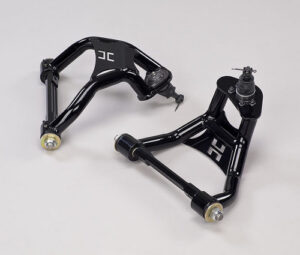
B or F Body Tall Spindle Conversion
#1103C This Hotchkis Sport Suspension Tubular Upper A-Arm is designed for vehicles using F or B Body Spindles, or aftermarket “Tall” spindles. This very popular conversion improves the poor handling positive camber curve A-Body vehicles have when using stock spindles. Positive camber curve is when the the tire lays outwards under cornering or suspension compresion. This causes the tire to roll over, loosing tire contact patch, and traction. Increasing the height of the spindle, and using an appropriate A-Arm, the vehicle will have a negative camber curve, thus pulling thetop of the wheel in, allowing more tire contact as the vehicle rolls into a corner.
Features: Smooth operating Delrin® bushings, 4130 chromoly offset cross-shaft for increased camber adjustment and built in positive caster. Precision CNC bent tubing is 100% TIG welded, and finished in gloss black powder coat. MADE IN THE USA
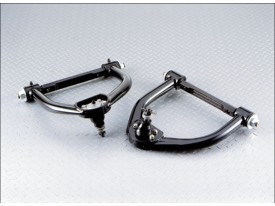
Q) When should I fully tighten my A-Arm?
Answer: Tighten the bolts with the full weight of the vehicle on the ground. The reason for this is by tightening the A-Arms when the vehicle is fully weighted, you reduce the pre-load on the bushings and allow the vehicle to sit at final ride height.
Q) Will the Hotchkis part number 1103C work with my stock spindles on my 64-72 A-body?
Answer: No, they will not work with the stock spindle. Our 1103C tubular upper a-arms require the use of late model taller spindles and brakes, for improved suspension geometry and stopping power. In order to run our upper a-arms Part # 1103C you do have to change the factory spindles to the B-body spindle (1978-1996 Impala, caprice ect) or F-body spindle(1970-1981 Camaro, Firebird). For the stock spindle applications use item #1102.
Q) Do the outer tie rods have to be changed with the 1103C or “Tall Spindle” Conversion?
Answer: When doing the “Tall Spindle” conversion using F or B Body spindles, you must use the appropriate outer tie rod ends for the spindle.
64-70 A-Body Cars will use outer tie rod ends from a 78-88 G-Body
71-72 A-Body Cars will use outer tie rod ends from a 73-77 A-Body
78-88 G-Body can reuse the stock outer tie rod ends.
Q) Will the B & F Body spindles lower vehicle?
Answer: Yes, 3/4″ of an inch.
Q) Will the B & F Body spindle widen track width?
Answer: Yes, 3/8″ of an inch per side.
Q) What are the alignment specs when running the Hotchkis part number 1103C?
Answer: Caster 4+ Driver Side and 4.5+ Passenger Side, 0 Camber and 1/16 total toe in.
Q) Where does the trailing arm mount brace go?
Answer: The trailing arm brace connects the upper trailing arm mount to the lower trailing arm mount, connecting the two points together reducing chassis flex.
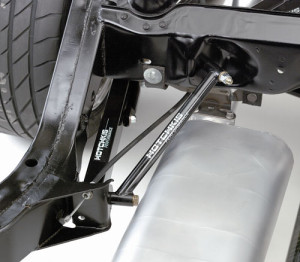
Q) Why should I use the HPS 1000 shocks over the “off the shelf” BilsteinTM?
Answer: Shocks need to be tuned with spring rates and vehicle weights in mind, that’s why one valve fits all or universal shocks just don’t optimize performance and often sacrifice ride comfort for performance. Tuned in house and manufactured by BilsteinTM, this shock offers a seamless transition between comfort and control. Each shock is specifically engineered and tuned to offer the ultimate performance ride.
Q) Do shocks come with your TVS kits?
Answer: No, they do not. You still have a choice of what shocks you prefer. We strongly recommend the HPS 1000 shocks so you will be using matched product.
Q) Which side goes towards the top when installing my springs 1901F/1916F?
Answer: The flat side goes towards the top!
Q) What direction should I install my springs?
Answer: You will want to install your springs with the part number right side up, unless special instructions are included with the item.
Q) Do the springs settle?
Answer: The springs settle within the first 5 miles of driving the vehicle.
Q) Will weight reduction to my vehicle affect ride height?
Answer: Yes. Any weight reduction from factory parts will affect ride height.
Q) What coil springs/TVS kit should I buy if I have a big block with aluminum heads?
Answer: Buy the small block springs/ TVS kit.
Q) I want to lower my car, but do not want to give up my ride quality; will Hotchkis springs ruin my ride characteristics?
Answer: Our engineers are familiar with the balance of optimizing handling while maintaining ride quality. Our springs will provide the handling and precise vehicle responsiveness and stability with little effect to the ride quality.
Q) Is it necessary to have my vehicle aligned after installing a Hotchkis spring kit?
Answer: Yes. Any time you work on the suspension system and after the ride height, it is necessary to check and adjust the alignment of the vehicle. By lowering the ride height, some camber and toe may be affected.
Q) Will I have proper tire clearance with a “Larger” wheel & tire package after installing a Hotchkis spring kit?
Answer: All Hotchkis suspension kits are designed and tested around the vehicle’s original wheel and tire combination. It is best to work with a reputable wheel and tire dealer that is knowledgeable in the proper wheel size (width and offset) that is correct for your vehicle in order to prevent clearance problems caused by improper wheel and tire packages.
Q) How do I measure ride height?
Answer: Using a tape measure, measure the height from the fender lip to the ground.
Q) I have a squeak coming from one of my sway bars? What can it be?
Answer: Urethane bushings often make noise when the temperature is cold or they are not adequately greased. Try greasing the sway bar bushings with any non-lithium based moly grease. A Special silicon grease for polyurethane can be purchased from Hotchkis. Item 3101.
Q) What are the advantages of the extreme rear bar 2282R over the 2202R?
Answer: The 2282R Extreme Rear Sway Bar (shown below) offers a few advantages over the 2202R standard upgrade bar. The 2202R bar is designed just like the factory bar where it is bolted between two trailing arms. The problem with this design, is without the use of end links, the bar causes binding and is sometimes prone to breakage. Knowing this, we designed the Extreme Sway Bar. This design clamps to the axle tubes using the supplied brackets and stainless steel u-bolts, while it attaches to the trailing arms using dog bone links. This design allows us to get better articulation from the suspension and less bind. A second advantage to this design is the adjustable bar. This allows the user to pick between two different bar rate, and stiffness’. The third advantage is the light weight tubular design. This allows us to create a strong, lightweight product that allows years of service.
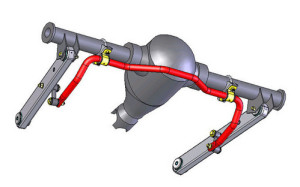
Q) Do you make custom sway bars?
Answer: No we do not make custom sway bars.
Q) What can I use to clean the excess grease off my sway bars and bushings?
Answer: With WD40 you can clean off excess grease from the bushings and sway bar.
Q) Are solid sway bars stronger than hollow sway bars?
Answer: Sway bars work off of torsional force (twisting motion). Therefore, the material in the center of a solid bar plays little role in the resistance of torsional force. With this in mind, we have eliminated some of the center material and also moved some to the outside of the tube, where it is most effective. In turn, this produces a sway bar that is lighter in weight and just as stiff, if not stiffer than solid. For example, a 1 3/8″ hollow bar is equivalent to a 1’1/4″ solid. But the 1’3/8″ hollow bar is 6% stiffer and 43% lighter than the 1’1/4″ solid. Interested in finding out more about Hollow Sway Bars?
Q) Why do you sell sway bars only in pairs? (For the exception of some applications)
Answer: To get the optimum handling performance out of your car, it is imperative to use both the front and rear bars together. Our “hands-on” road-testing behind our bars indicate that both the front and rear sway bars must be used to produce maximum handling results for your vehicle. Thus only using one bar is not recommended when trying to achieve the best results.
Q) What makes Hotchkis Trailing Arms better than the competition?
Answer: Size Does Matter! Hotchkis Trailing Arms are built to take the abuse of high horsepower applications while still offering a comfortable ride.
There are many trailing arms and rear suspension solutions on the market and to the untrained eye they all look similar. Here are some of the key features that make Hotchkis trailing arms the strongest in the market.
Hotchkis Trailing Arms (right), are formed from one section of 1.5 x 3″ .120 wall tube. This gives Hotchkis Arms incredible strength and rigidity. Our competition (left) chooses to weld a tail section to their trailing arm, creating a weak point. Notice how the arm on the left is cracked and separating from the main body. Notice the size difference of the Hotchkis Arm (right). Both the bushing, and the body of the arm are notably larger. This is a like comparison of GM A-body Non Adjustable Upper Trailing Arm. Larger bushings and super strong 1.5″ x 3″ .120 wall rectangular tubing make Hotchkis Trailing Arms unmatched in strength. Another often overlooked feature is the method the bushing tube is attached to the arm. The competition chooses to weld a round tube to the end of a rectangular body. This weld can fracture under high loads. Hotchkis Trailing Arms feature a bushing that is set into the original parent material. Notice how the ends are wrapped around the bushing and TIG welded. The bushing would have to be ripped from the parent material in order to fail.
Hotchkis arms are Designed, Built, and Punished in the USA.
Hotchkis arms are Designed, Built, and Punished in the USA.
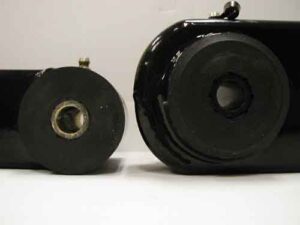
Hotchkis adjustable upper trailing arms feature massive 1 1/2″ billet aluminum center sections for superior strength and durability. Tail sections are formed from .120″ wall steel, TIG welded for strength, and mated to 7/8″ studs for added strength and durability. The Swivel Max, greasable bushing allows for added articulation, and quiet operation.
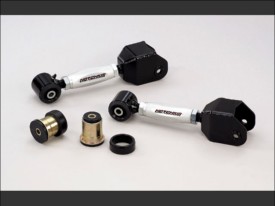
Q) I have heard that polyurethane bushings bind. Is that true?
Answer: The A-body rear suspension uses a series of two different length trailing arms, the amount of articulation required during extreme cornering is quite minimal. Our unique polyurethane bushings have more than adequate articulation resulting in bind free suspension movement throughout the full range of travel. Hotchkis Sport Suspension has been using polyurethane busings in the A-Body upper and lower trailing arms for over 15 years, and we are constantly looking for better ways to design products, but the truth of the matter is, for street applications the unique polyurethane bushings used in these arms offers a great level of performance while still maintaining a comfortable ride.
For a demonstration of these arms in action please watch the video below.
Q) Should I wait until the vehicle is on the ground before tightening the bolts?
Answer: Yes. As a rule of thumb you should always tighten suspension bolts when the full weight of the vehicle is on the ground.
Q) Will your trailing eliminate wheel hop?
Answer: The Hotchkis trailing arms will reduce wheel hop but may not eliminate wheel hop on every vehicle. There are many factors that affect wheel hop on cars. Tire Pressure, Tire Type, Shock Technology, Spring Rates, and Vehicle Height all affect wheel hop. Pinion angle is also a factor which would cause wheel hop and drive line vibration. Some high horse power cars could need additional traction devices, but as a good rule of thumb, the best place to start is by upgrading your trailing arms with a Hotchkis Adjustable Rear Suspension Package.
Q) Is there an optimum pinion angle?
Answer: Due to the nature of an automobile chassis, the various angles are constantly changing, which adds to the complexity of obtaining optimum pinion angle. Engines may not sit squarely in their motor mounts, motor mounts may not sit properly between the frame rails, cross members may not sit straight, and where the rear end is positioned. Despite all these factors affecting the positioning of our drive trains, they seem to work well enough in most cases, at least on the street in basically stock applications. We owe this functionality to the universal joint, which, by design, corrects for slight misalignments between the driving components (crankshaft and transmission) and the driven components (driveshaft and differential) of the drive train. (Please see the tech section to learn how to set your pinion angle.)
Q) Where does the trailing arm mount brace go?
Answer: The trailing arm brace connects the upper trailing arm mount to the lower trailing arm mount, connecting the two points together reducing chassis flex.
